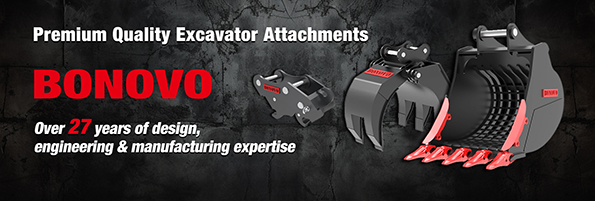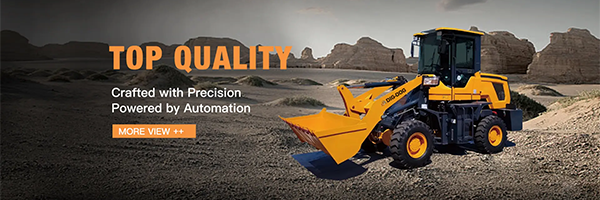1. Preparation
(A) Confirm the suitable loader model
Different brands and models of loaders, its accessory interface, power output and other parameters are different. When selecting a cleaner, be sure to check the loader's product manual to determine its applicable cleaner specifications. For example, Liugong 856H loader, the adapted cleaner has specific requirements in connection size, hydraulic interface, etc., which is the basis for ensuring the smooth follow-up installation and operation, "loader model and cleaner adaptation" is the key point.
(2) Check the integrity of the cleaner components
After receiving the cleaner, carefully inspect the components. Check whether the brush is worn, deformed, and whether the bristles are thick; Transmission components such as chain, gear and other rust, damage; The bolts and pins at the connection parts are complete. At the same time, check whether the pipeline of the natural air purging device is cracked and blocked, and whether the outlet is smooth. The problem of any part may affect the cleaning effect and the normal operation of the equipment, which is related to the importance of "the inspection of the loader accessories cleaner parts".
(3) Site survey
Conduct a thorough survey of the site to be cleaned before operation. Understand the topography of the site, whether there are obstacles, potholes, etc.; Determine the area to be cleaned and the general distribution of garbage and dust. For example, in the construction site, pay attention to avoid the construction equipment and building materials stacking area, and plan the cleaning route in advance, which involves the key link of "loader cleaning site planning".
Second, install the cleaner and natural air purging device
(A) cleaning device installation
Move the cleaner to a suitable position in front of the loader and align it with the loader mounting interface. A pin or bolt connection is usually used to firmly connect the installation frame of the cleaner to the working device of the loader. Ensure that the connection is tight, the pin is inserted in place, the cotter pin is installed, and the bolt is tightened to the specified torque to prevent the cleaner from falling off during operation.
Connect the hydraulic line of the cleaner (if hydraulically driven). Find the loader's backup hydraulic interface, which is usually located on the side of the loader's arm or under the cab. Connect the hydraulic tubing of the cleaner with the hydraulic interface of the loader, and pay attention to the cleanliness of the interface to avoid impurities entering the hydraulic system. Connect the oil pipe in the correct direction to prevent distortion and winding, and fix it firmly with a special pipe clamp, which requires higher accuracy for the "hydraulic pipe installation of the loader cleaner".
(2) Installation of natural air purging device
The natural air purging device is generally composed of an air inlet, a pipeline and an outlet. Install the air intake in the proper position of the loader to ensure that it can draw sufficient and clean natural air. For example, it can be mounted on the top of the cab or on the side of the engine compartment, away from dusty areas.
The purging pipe is arranged along the structural frame of the loader, and the pipe clamp or fixed bracket is used to fix the pipe firmly to prevent the pipe from shaking and falling off during the driving process. The direction of the pipeline should be reasonable to avoid interference with other parts of the loader.
Install the air outlet behind or to the side of the cleaner, so that it can be aligned with the cleaned ground, and residual dust and small debris further away. The Angle of the outlet can be adjusted according to the actual cleaning needs, and it is generally more appropriate to have an Angle of 30° -45 ° with the ground, which is the key point of "Loader natural air purging device installation adjustment".
3. Operation process
(1) Check before starting
Check again whether the installation part of the cleaner and natural air purge device is firm, whether the hydraulic pipeline is leaking, and whether the pipeline connection is tight. Start the loader, let the working device do some simple actions, and observe whether the connection part of the cleaner is loose.
Check the rotation flexibility of the brush and manually turn the brush to ensure that it is free of stashes. At the same time, check whether the outlet of the natural air purging device is blocked by foreign matter, you can briefly start the engine of the loader to observe whether there is air blowing out of the outlet, which is a necessary step of "check before the loader cleaning operation starts".
(2) Cleaning operation
Start loader and drive slowly to clean area. According to the site conditions and garbage distribution, choose the right speed, generally 5-10 km/h is more appropriate. Too fast speed may lead to incomplete cleaning, too slow will affect the work efficiency, which involves the "loader cleaning operation speed selection" key points.
Operate the loader control handle and lower the sweeper so that the brush touches the ground. The pressure in contact with the ground should be moderate and can be controlled by adjusting the lifting or lowering of the loader's working device. Too much pressure may damage the brush and the ground, too little cleaning effect is not good.
Turn on the power unit of the sweeper (such as a motor or hydraulic motor) so that the brush starts to rotate. At the same time, start the natural air purging device, adjust the wind size and Angle of the outlet, so that it can effectively blow away the dust and debris swept up by the sweeping brush. For dusty areas, the wind can be appropriately increased; For more fragile ground or areas that need fine cleaning, the wind is reduced, which is the embodiment of the "loader cleaner and natural air purge collaborative operation skills".
In the cleaning process, we should always pay attention to the cleaning effect and the operating status of the equipment. If it is found that the cleaning brush is seriously worn, the cleaning is not thorough, or the natural air purge device has abnormal noise, insufficient wind, etc., it should immediately stop the operation, check the cause, and repair or adjust.
(3) The cleaning operation is finished
After finishing cleaning the area, turn off the power unit of the cleaner and the natural air purge unit. Operate the loader control handle and lift the cleaner to a certain height off the ground.
Drive the loader slowly away from the cleaning area and park the equipment in the designated safe position. Clean the debris attached to the cleaner and natural air purge device, especially the cleaning brush and the outlet part, to keep the equipment clean. This is an important part of "cleaning after the loader cleaning operation".
Fourth, maintenance
(1) Daily maintenance
Clean the cleaner and natural air purge after each job. Use a brush or compressed air to clean the debris and dust wrapped on the brush; Check the surface of the pipeline for dust accumulation and clean it up in time.
Check the transmission parts of the cleaner, such as chain, gear, etc., add the appropriate amount of lubricating oil to maintain its good operating performance. The air inlet filter screen of the natural air purging device is cleaned to prevent dust from clogging the filter screen and affecting the intake volume, which is related to the "daily maintenance points of the loader cleaning equipment".
(2) Regular inspection
Regularly check the wear of the brush, when the brush hair wear is more than one-third, the brush should be replaced in time to ensure the cleaning effect.
Check whether the pipeline connection part of the natural air purge device is loose, and whether the pipeline has cracks, deformation and other problems. If there is a problem, repair or replace it in time.
Check the hydraulic system of the loader (if the cleaner is hydraulically driven) to see if the hydraulic oil level is normal and the oil quality is clean. If the oil level is too low, timely supplement hydraulic oil; If the oil quality deteriorates, the hydraulic oil should be replaced, which involves "the key link in the regular maintenance of the loader cleaning equipment".
Proper operation of loader attachment cleaners combined with natural air purging
- BONOVO
- Counselor
- Posts: 645
- Joined: Oct 17th, '24, 02:50
- Location: China
Proper operation of loader attachment cleaners combined with natural air purging
Choose BONOVO for high-quality, customizable brush cutters for skid steers with fast delivery. Contact us today to discover how our superior products can enhance your land management tasks!
for more info just visit our website at www.bonovogroup.com
contact # : +86 158 6218 2088
email : sales@bonovogroup.com
for more info just visit our website at www.bonovogroup.com
contact # : +86 158 6218 2088
email : sales@bonovogroup.com

